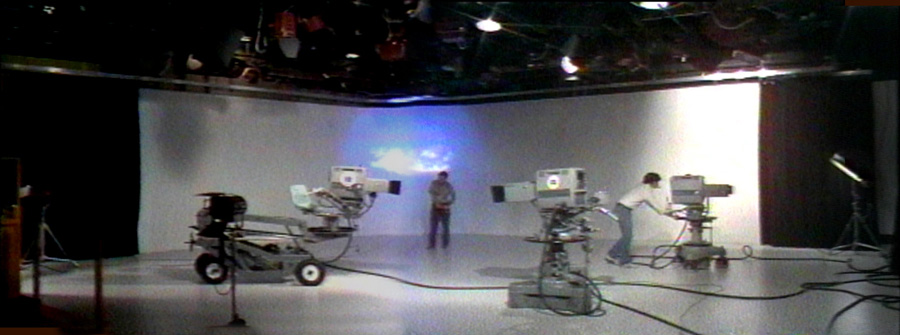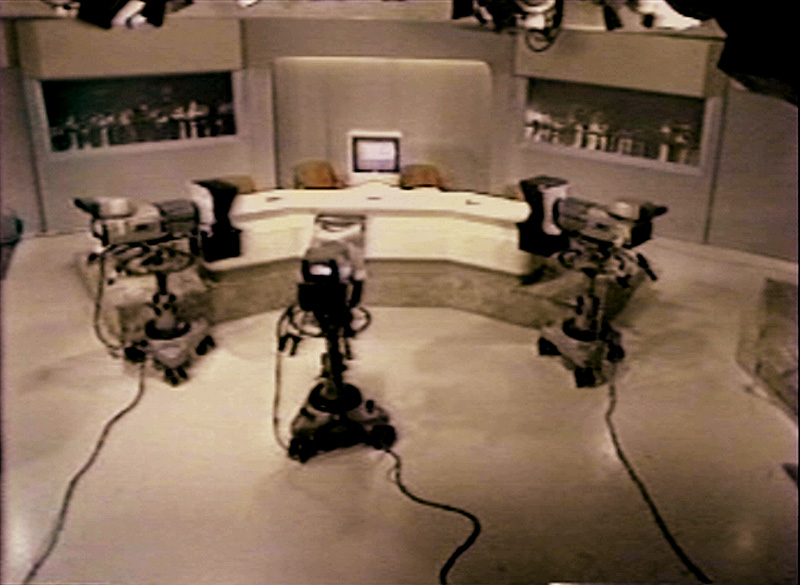The Pulse News set in the mid-1970's. Production came to a halt daily around 5pm to prepare for the live newscasts
"…THESE SMALLER BOUTIQUES OPENED UP AND BEGAN TO SIPHON OUR BUSINESS AWAY…"
The Pulse News set in the mid-1970's. Production
came to a halt daily around 5pm to prepare for the live newscasts
By the
mid 1970's studio production at Channel 13 was non-stop between the live Pulse
newscasts, pre-recorded public service programming such as High-Q,
Church Service, and Black Contact. Commercial production was
sandwiched in between the close of Pulse Plus! at 1pm and the start of
Pulse news at 5pm. It was an uncomfortable squeeze for Channel 13's
commercial clients. "In those days we'd do commercials in Studio B and it
became apparent that clients needed more time than the two or three hours
between live newscasts," explains Jim. "Studio 13 was created to give clients
the time they needed and some editing facilities. We built Studio 13 next to
the old film lab and used the mobile unit as our control room."


Studio 13 allowed the crew to work without interruption
from Pulse News.
Camera operator John Sizemore is on the Vinton crane assisted by Paula Blauschka.
"We had the three
Norelco cameras off the mobile unit, a great lighting package, a set
construction area and the use of our dedicated studio, which was about 50' by
50'. That's how we produced the first year of The John McKay Show.
Studio 13 started off well and ran for a couple of years but then these smaller
boutiques opened up and began to siphon our business away."
Engineer Bill Napier and the aborted mobile unit
In late 1979, a new semi-tractor/trailer was purchased to replace the aging 1968 mobile unit, but management decided that the high cost would not be a sound financial investment. The unfinished unit was sold and WTVT was out of the commercial remote business. "We had a pretty good crop of people up until the time we stopped doing remotes," explains Jim. "I think when we stopped that a lot of people decided to try their skills elsewhere or move on. Although it was a wise decision financially, getting out of the remote business kind of broke our backs in production and the commercial business went to small production companies. It was sad because the mobile unit showed our presence in the community. The community loves these things, and that's a lot about what TV stations are about….working in the community and letting them know you're there for them. You go to their hometown and that's a big deal for them. A lot of the crew, myself included, relished going on the remotes and seeing exciting places and people."

Jim's late 70's employee portrait.
It was at a juncture that he considered leaving WTVT
With the mobile unit gone and commercial production on the wane in Studio 13 Jim doubted that he had a place in the future of WTVT. It was time for him to pause and reflect. "I had a couple of offers…one from CNN in Atlanta and another from GTE in Tampa…WFLA too, but they were looking for a producer. But I'd put in almost twenty years by that time and had no compelling reason to leave. I had to change my mindset from commercial production to news production."
The 1980's brought technological innovations to WTVT in the form of satellite trucks, sophisticated special effects generators, graphic packages, and frame-accurate editing.

The 1980's Pulse13 news set covered half of Studio B's
floor space
The most dramatic change for Jim and his production crews was the surrender of Studio B to accommodate a new, larger Pulse set. Positioned on the studio's south wall, the Pulse set now took up half of Studio B. No longer was any kind of non-news production possible. "Commercial production was mostly gone and we still had Studio 13, but the was writing on the wall," states Jim. "We had Publix every Wednesday and Belk Lindsey on Mondays but that eventually came to an end."
From that time on remotes were limited to using the GMC unit at the Florida State Fair for Pulse Plus! and occasional live news coverage.

Jim with WTVT's first satellite truck,
Newstar 13